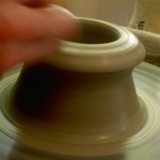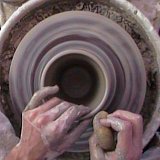|
Clay Pot Patterns - VasesHere are a few clay pot patterns for vases. Because of their height and shape, vases are generally more difficult than bowls and mugs. They become extremely difficult when you start creating very tall and very curvy vase shapes. Some even seem to want to defy gravity. Take a look at the examples below.
The first pot on the left there is a basic vase shape. It has a very functional shape. It's also fairly easy to make due to it's mellow curves and open neck (allows easier access for your inside throwing hand). As you move to the right in the line, the first five pots are variations of the basic vase. By widening the rim, or narrowing the rim, or narrowing it a lot, it changes the function as well as the look of the vase. Often, narrower vases are more challenging to throw. They allow less room for a hand to fit inside. Therefore, advanced techniques are required. An example of an advanced technique is using a throwing stick, which reaches down the narrow neck of the vase. Another example is throwing a wide enough vase for the hand to fit inside, then closing it up just before the pot is finished. A final example is throwing ceramic floor vases in two parts. This allows you to form a larger, more complex shape out of two smaller, easier to throw, shapes. Take a look at the two designs on the far right. These two vases are top weighted. Their narrow bases and wide shoulders gives them a unique, delicate feel. If a vase seems too top heavy, the base could be made wider to provide more stability, while still maintaining a delicate feel. Thanks for reading about vase designs. If you need other patterns check out this beautiful book 500 Vases: Contemporary Explorations of a Timeless Form Return From Clay Pot Patterns - Vases |
Learn Right
The First Time
Pottery on the Wheel for Beginners
is a complete beginners guide
to learning pottery.
It will
take you from
never having touched clay
to creating finished pottery
you can use every day.
Also read it on Kindle
Featured Pages
Choose Your Wheel
Thank you so much for
visiting my website!
Discover How I Made It!
Happy Potting!
- Steve











